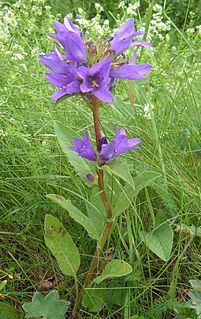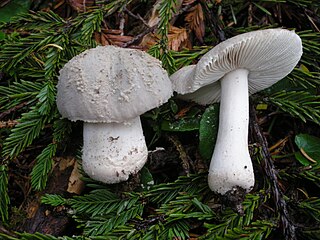
Encelia is a genus of the plant family Asteraceae. It consists of shrubs of arid environments in southwestern North America and western South America.

Encelia farinosa, is a common desert shrub of northern Mexico and the southwestern United States.

The southern mealy amazon or southern mealy parrot is among the largest parrot in the genus Amazona, the amazon parrots. It is a mainly green parrot with a total length of 38–41 cm (15–16 in). It is endemic to tropical Central and South America. This species and the northern mealy amazon were previously considered conspecific. Some taxonomic authorities (including the American Ornithological Society, continue to lump them together.

Campanula glomerata, known by the common names clustered bellflower or Dane's blood, is a species of flowering plant in the genus Campanula, belonging to the family Campanulaceae. It is the county flower of Rutland, England.

Amanita farinosa, commonly known as the Eastern American floury amanita, is a North American poisonous mushroom of the genus Amanita, a genus of fungi including some of the most deadly mushrooms, as well as notably psychoactive mushrooms.

Peronospora farinosa f.sp. betae is a forma specialis of Peronospora farinosa, attacking sugar beet.

Dudleya farinosa is a succulent plant known by several common names, including bluff lettuce, powdery liveforever, and powdery dudleya.

Acacia farinosa, commonly known as mealy wattle, is a shrub that is endemic to Australia. It grows to between 1 and 2 metres high and has ascending phyllodes. The yellow globular flower heads generally appear between August and October in its native range. These are followed by curled and twisted pods which are up to 6 cm long and 2–3 mm wide.

3-Acetyl-6-methoxybenzaldehyde is a chemical compound found in the leaves of Encelia farinosa.

Monochroa servella is a moth of the Gelechiidae family. It is found from Fennoscandia to Italy and from Portugal to Bulgaria and Russia.

Aletris farinosa, called the unicorn root, true unicorn, crow-corn, white colic-root or white stargrass, is a plant species found across much of the eastern United States. It has also been reported from the southern part of Ontario, Canada. It is known from every state east of the Mississippi River except Vermont, as well as Texas, Oklahoma, Arkansas and Louisiana.

Mesosini is a tribe of longhorn beetles of the Lamiinae subfamily.
Aemocia is a genus of longhorn beetles of the subfamily Lamiinae, containing the following species:
Aemocia balteata is a species of beetle in the family Cerambycidae. It was described by Francis Polkinghorne Pascoe in 1865. It is known from Moluccas.
Aemocia borneana is a species of beetle in the family Cerambycidae. It was described by Stephan von Breuning in 1974. It is known from Borneo.
Aemocia griseomarmorata is a species of beetle in the family Cerambycidae. It was described by Stephan von Breuning in 1970. It is known from Moluccas.
Aemocia ichthyosomoides is a species of beetle in the family Cerambycidae. It was described by James Thomson in 1864. It is known from Moluccas.
The mealy amazon has been split into the following species:

Gonepteryx farinosa , the Powdered Brimstone, is a butterfly found in the Palearctic that belongs to the whites family.

Penthicodes farinosa is a species of bugs in the sub family Aphaeninae (Fulgoridae): with five subspecies distributed in Indo-China and Malesia.













